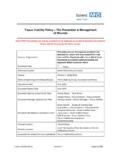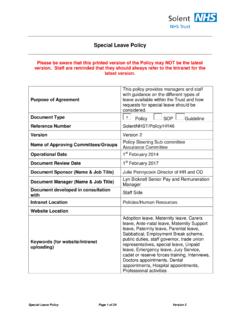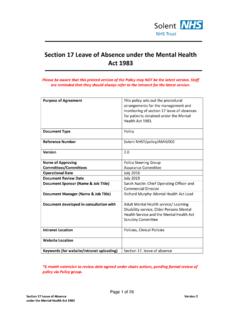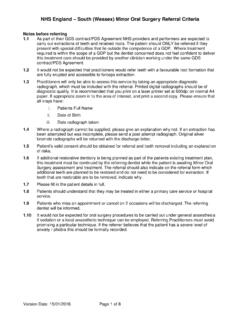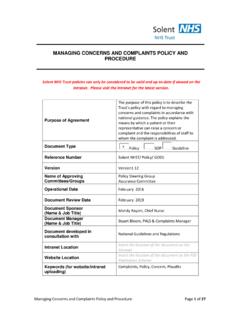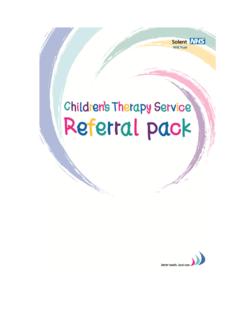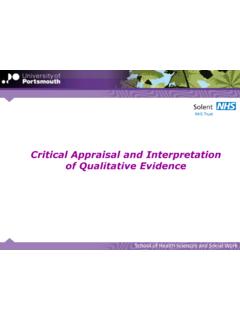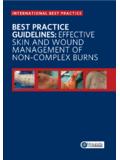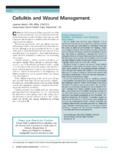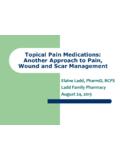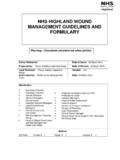Transcription of Wound Formulary - solent.nhs.uk
1 Basingstoke, Southampton and Winchester District Prescribing Committee and Portsmouth and South East Hampshire Area Prescribing Committee Wound Formulary HANDBOOK February 2013 Wound Formulary February 2013 version Ratified by the Basingstoke, Southampton and Winchester District Prescribing Committee and Portsmouth and South East Hampshire Area Prescribing Committee Version Wound Formulary 2 Introduction Dressings are only one component of Wound care and, on their own, will not heal wounds. It is assumed that each healthcare professional will be responsible for ensuring they are up to date with current Wound /skin care practice and ensure they are familiar with the products selected for use.
2 The purpose of the Hampshire wide Wound Formulary is to provide a list of dressings, bandages, hosiery and topical applications which based on the evidence available should be selected for approximately 90% of prescribing in this area. There may be a small number of occasions when, after using the Wound Formulary 1st and 2nd line, you consider a non- Formulary product may be appropriate. (In secondary/acute care settings there may be differences due to availability and procurement routes which will be highlighted where known-please refer to local protocols) The Wound Formulary is to be a working document with input from all disciplines across nursing, pharmacy and podiatry within acute and primary care. The Wound Formulary Group continues to meet to provide a forum for the evaluation of new and current products and to document the evidence available for inclusions to the Wound Formulary for consideration by the District Prescribing Committee.
3 Product selection has been based on evidence of efficacy (although there is little research evidence available), manufacturers literature, practical experience of use and cost effectiveness. The recommendations have been developed by collaboration between health professionals from primary care and secondary care. In the Wound Formulary we have provided an Exception Reporting form (available electronically) for use when non- Formulary products are used. The information that you provide will be reviewed by the Wound Formulary Group and will be taken into consideration when the Formulary is revised and updated. The Wound Formulary Group requires feedback/comments/rationales on the form. (See last section at bottom of page) The group also value any comments you have regarding this edition of the Formulary . This is your Wound Formulary and it will only work if you take ownership of it.
4 Note the costings in this document are for single dressings/units, based on Drug Tariff prices unless otherwise stated and were accurate at time of printing. NB Not all products are available in secondary care. Please refer to local policy. General References sources: BNF Sept 2012: 64, SHIP Guidelines for Antibiotic Prescribing in the Community 2012, Journal of Wound Care Handbook , , , , , , , , Wound Formulary February 2013 version Ratified by the Basingstoke, Southampton and Winchester District Prescribing Committee and Portsmouth and South East Hampshire Area Prescribing Committee Version Wound Formulary 3 CONTENTS PAGE 1.
5 NON/LOW ADHERENT DRESSINGS 4 2. ADHESIVE FILM 4 3. TOPICAL ANTIBACTERIALS 5 4. ODOUR CONTROL 7 5. ALGINATES 8 6. PROTEASE MODULATING MATRIX 8 7. HYDROGEL 9 8. FOAM DRESSINGS 10 9. HYDROCOLLOIDS 11 10. PASTE BANDAGES 11 11. BANDAGES 12 12. SUPPORT HOSIERY 15 13. ADHESIVE TAPE 17 14. ABSORBENT DRESSINGS 17 15. MISCELLANEOUS 18 Appendix 1 and 2 20 Appendix 3 Best Practice in Older Person s Skin Care 21 Appendix 4 Skin Tears Superficial Burns/Scalds Epithelialising Wounds Granulating Wounds Over Granulation Sloughy Wounds Necrotic Wounds Critically Colonised or Infected Wounds 22 23 24 25 26 27 28 29 Appendix 5 Multilayer Compression Bandage Adaptation Chart 30 Appendix 6 Critically Colonised/Infected Wound Sign Checker and Flow Chart 31 Appendix 7 Resource Page 33 Appendix 8 Exception Reporting Form 34 Wound Formulary February 2013 version Ratified by the Basingstoke.
6 Southampton and Winchester District Prescribing Committee and Portsmouth and South East Hampshire Area Prescribing Committee Version Wound Formulary 4 Product Type Product Name Size Cost/ Item Comments 1. NON/LOW ADHERENT DRESSINGS Atrauman 5x5cm 10x20cm 20x30cm 26p 27p 61p Knitted polyester dressing impregnated with neutral triglycerides. May not be suitable for patients with sensitivities to coconut or its derivatives. Consider Tricotex for patients with coconut allergy. 1. Consider Mepitel for large skin tears where the skin flap needs immobilising. 2. Tricotex is suggested as an alternative for simple non adherent dressings NB An Exception reporting form will be needed in both instances.
7 Choice of dressing for use under topical negative pressure is determined by local specialist advice Softpore 6x7cm 10x10cm 10x15cm 10x20cm 10x25cm 10x30cm 6p 13p 20p 35p 40p 49p NOT to be used on post operative wounds or skin tears. Nor on fragile skin. Only use on minor superficial wounds where all that is required is protection from friction. 2. ADHESIVE FILM Vapour permeable film Hydrofilm 6x7cm 10x15cm 10x25cm 12x25cm 15x20cm 20x30cm 22p 40p 51p 79p 83p 93p Dry, non-infected wounds; retention of lines; fixation of secondary dressings. NB: management of IV sites refer to local guidelines . Wound Formulary February 2013 version Ratified by the Basingstoke, Southampton and Winchester District Prescribing Committee and Portsmouth and South East Hampshire Area Prescribing Committee Version Wound Formulary 5 Product Type Product Name Size Cost/ Item Comments Management of critically colonised and infected wounds Appendix 5 for Sign Checker, flow chart and guidance on choice of dressings.
8 All antibacterial dressings should be used for two weeks only. Expert advice and guidance should be sought if antibacterial dressings are required for a longer period. NB: all antimicrobial dressings to be cut to size of Wound . Do not apply to intact skin. 3. TOPICAL ANTIMICROBIALS a. Iodine based Inadine Iodoflex 5x5cm 5g 10g 17g 33p 49p Non-adherent dressing impregnated with 10% povidone-iodine. Colour change indicates when to change dressing. Management and prevention of infection in ulcers, minor burns and minor traumatic skin injuries. Not effective in medium to heavy exudate Cadexomer dressing with iodine. For the treatment of chronic exuding wounds. Not to be used on dry necrotic tissue. Apply up to 50g per dressing change, cover with secondary dressing; change when paste is saturated.
9 Do not exceed 150g Iodoflex paste in one week or more than 3 months single course of treatment. BE AWARE OF CONTRAINDICATIONS FOR USE. 3. TOPICAL ANTIMICROBIALS (cont d) b. Honey Medihoney Medihoney Gel sheet Medihoney Tulle dressing Medihoney antibacterial honey apinate 20g 50g 5x5cm 10x10cm 10x10cm 10x10cm Medical honey. Useful on sinus wounds. Indicated for infected or critically colonised wounds. Can be effective if malodour present or as a sloughing agent. Gel sheet Wound dressing comprising antibacterial honey and sodium alginate, sterile. Honey is released more slowly than other honey products. Strong woven dressing impregnated with antibacterial honey, sterile. For superficial wounds. Non-adherent, non-absorbent, protease modulating matrix, sterile. Wound Formulary February 2013 version Ratified by the Basingstoke, Southampton and Winchester District Prescribing Committee and Portsmouth and South East Hampshire Area Prescribing Committee Version Wound Formulary 6 Product Type Product Name Size Cost/ Item Comments c.
10 PHMB and silver Suprasorb X + PHMB Acticoat Absorbent Aquacel Ag 5x5cm 9x9cm 14x20cm 2x21cm 5x5cm 2x30cm rope 5x5cm 10x10cm 15x15cm 1x45cm ribbon 2x45cm ribbon Light to moderately exuding, superficial and deep, critically colonised and infected wounds. Bio-cellulose dressing impregnated with broad-spectrum antimicrobial (PHMB (polyhexamethylene biguanide ). Can be effective if the Wound is infected and painful. A calcium alginate fibre coated on both surfaces with nanocrystalline silver. As an antimicrobial absorbent dressing over partial and full-thickness wounds which are exuding. Absorbent, white fibrous dressing composed of Hydrofiber (sodium carboxymethylcellulose), impregnated with ionic silver. Forms a coherent soft gel on contact with exudate.)
